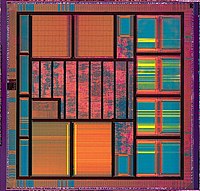
Photo from wikipedia
For high-tech manufacturing industries, developing large-scale complex nonlinear dynamic systems must be taken as one of the basic works, formulating problems to be solved, steering system design in a more… Click to show full abstract
For high-tech manufacturing industries, developing large-scale complex nonlinear dynamic systems must be taken as one of the basic works, formulating problems to be solved, steering system design in a more preferable direction, and making correct strategic decisions. By using effective tools of big data mining, Dynamic Design Methodology was proposed to establish a technical platform for Multidiscipline Design Optimization such as High-Speed Rolling Stock, including three key technologies: analysis graph of full-vehicle stability properties and variation patterns, improved transaction strategy of flexible body to MBS interface, seamless collaboration with weldline fatigue damage assessments through correct Modal Stress Recovery. By applying the above methodology, a self-adaptive improved solution was formulated with optimal parameter configuration, which is one of the more favorable options for higher-speed bogies. While within a velocity (140–200) km/h at λe < 0.10, car body instability’s influence on ride comfort can be easily improved by using a semi-active vibration reduction technique between inter-vehicles through outer windshields. Comprehensive evaluations show that only under rational conditions of wheel-rail matching, i.e., 0.10 ≥ λeN > λemin and λemin = (0.03–0.06), can this low-cost solution achieve the three goals of low track conicity, optimal route planning, and investment benefit maximization. So, rail vehicle experts are necessary to collaborate and innovate intensively with passenger transportation and steel rail ones. Specifically, by adopting rail grinding treatment, occurrence probability is controlled at 85% and 5% for track conicity of (0.03–0.10) and (0.25–0.35). By optimizing routing planning, operating across dedicated lines of different speed grades can achieve self-cleaning of central hollow tread wear over time. According to the inherent rigid-flex coupling relationship, geometric nonlinearities of worn wheel-rail contact should be avoided as much as possible for HSR practices. Only under weak coupling interfaces in the floor frame can the structural integrity of an aluminum alloy car body be ensured.
Journal Title: Applied Sciences
Year Published: 2023
Link to full text (if available)
Share on Social Media: Sign Up to like & get
recommendations!